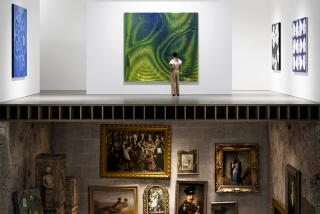The easy way to get into Harvard
CAMBRIDGE, Mass. — It’s no surprise that the art museums at Harvard University house one of the largest and most diverse collections in the country.
But unlike some things at the elite college, they’re surprisingly easy to get into.
Visitors with or without an Ivy League ID can enjoy the familiarity of the Old Masters at the Fogg Art Museum, experience the jarring German Expressionists at the Busch-Reisinger and take in a striking array of Korean ceramics, Chinese jades and Japanese woodblock prints at the Arthur M. Sackler Museum.
“We were stopped at the door of the Harvard library,” said Richard Keeling of Newport News, Va. “But we have incredible access here.”
Founded for research and teaching, the Harvard University Art Museums, just outside Harvard Yard, house more than 200,000 pieces of art, spanning antiquity to the present. There are more than 3,500 Western paintings and sculptures, including major works by Pablo Picasso, Edgar Degas, Vincent van Gogh and Jackson Pollack.
The museums also have more than 18,000 Asian works and more than 20,000 objects from ancient civilizations, including Greek vases, Roman portraits and antique coins.
The collection is half the size of Boston’s Museum of Fine Arts, for example, but it’s distinguished by its depth and ability to take risks.
“Our goal is a little different than the big blockbuster museums,” said Matthew Barone of the Harvard museums. “These are much more intimate galleries, where many exhibits are heavily researched, and sometimes even put together by classes at the college.”
That’s the case with a show at the Busch-Reisinger Museum, the only museum in North America devoted to the painting, sculpture and decorative art of Northern and Central Europe -- specifically, Germany.
A Harvard professor of Germanic languages and literatures collaborated with the museum on an exhibit focusing on art and literature around 1900. The display features artwork from Gustav Klimt and Egon Schiele next to early-edition books by Friedrich Nietzsche, Sigmund Freud and playwright Arthur Schnitzler, among others.
“Working with professors and students brings a freshness to the exhibits,” Barone said.
The Busch-Reisinger opened on the backside of the Fogg Museum in 1991. (It was founded in a different location in 1902 as the university’s Germanic Museum.) Visitors enter through the Fogg, which is Harvard’s oldest and most famous museum.
Opened in 1895, and occupying its current space since 1927, the Fogg has two floors of galleries stemming off a 16th century Italian stone courtyard.
Each of the 19 rooms displays something different -- such as Gothic art, 17th century Dutch and Flemish landscapes, and French paintings and drawings from the 18th century through the Impressionist period.
The artwork is displayed in a way to stimulate, rather than overburden, Barone said.
“It’s not overwhelming, but you get a bit of everything,” said Sally Boehme, who was visiting from Redding, Calif.
Visitors can see much of the art up close by requesting to view paintings, drawings and other works from the museums’ study centers.
“You want to see a Rembrandt? They’ll just bring them out and you can thumb through them. Anyone can. That’s not very common,” said Richard Benefield, deputy director of the museums.
Benefield said the museums’ association with Harvard has its pluses. Most of the collection comes from alumni donations, and Harvard alums span the globe, have varied interests and often have access to unique pieces.
The Fogg Museum gained international recognition when Harvard graduate Grenville Winthrop bequeathed his entire collection of Asian and Western art -- about 3,000 objects -- to the museum in the early 1940s. With the donation, the Fogg attained the largest holdings of works by J.A.D. Ingres outside France and the largest holdings of ancient Chinese and ritual bronzes anywhere in the world, Benefield said.
The art museums operate on a $21-million budget that is separate from the university, and have an endowment of $450 million, Benefield said.
Admission to the museums costs $7.50, compared with the Museum of Fine Arts ($15) and New York’s Museum of Modern Art ($20).
“We’ve been able to manage the finances very well and keep costs down,” Benefield said.
Admission is free for Cambridge library card holders, the Harvard community and people younger than 18. There is also free admission Saturday mornings.
“Simply put,” Barone said. “We want people to be able to come here and enjoy the art without breaking the bank.”
More to Read
The biggest entertainment stories
Get our big stories about Hollywood, film, television, music, arts, culture and more right in your inbox as soon as they publish.
You may occasionally receive promotional content from the Los Angeles Times.










